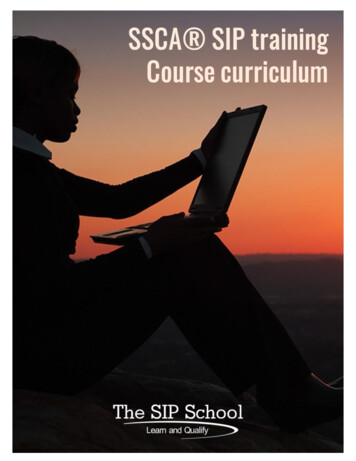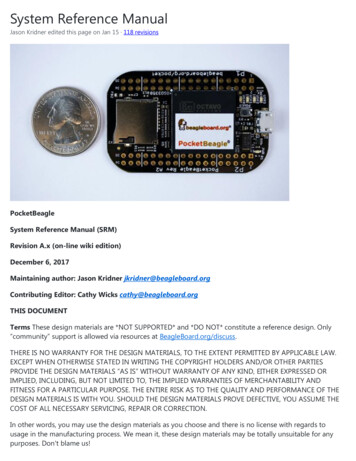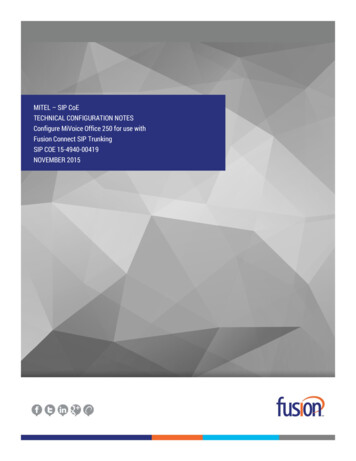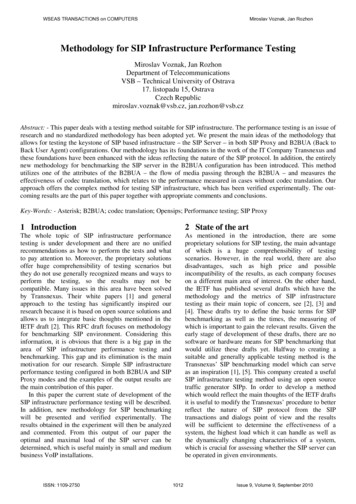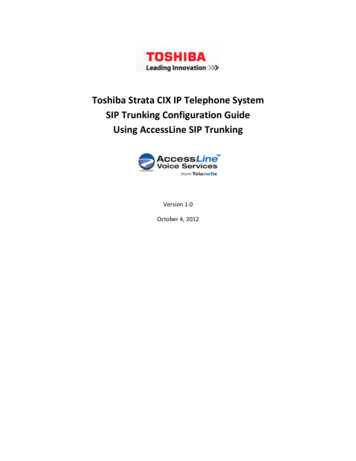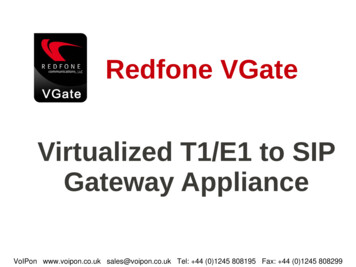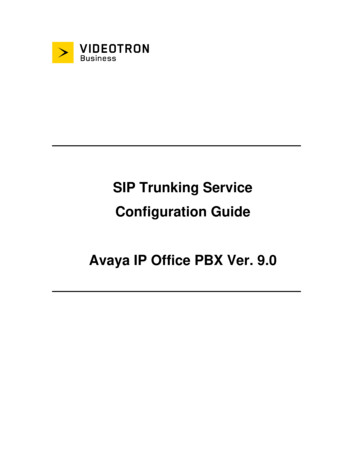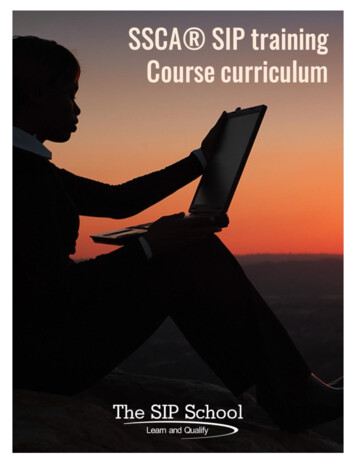
Transcription
The SSCA SIPtraining programThe SSCA SIP training programOverviewThe SIP School is ‘the’ place to learn all about the Session Initiation Protocol alsoknown as SIP. There is so much information on the internet about SIP that is bothhard to read and poorly presented making it difficult for people to learn about this mostimportant protocol. So The SIP School with its lively, clear and fully animatedeLearning program has become the only place you need to learn about SIP.Who would benefit from the SSCA SIP training program?Everyone ! This training is designed to suit anyone working with SIP such as:Manufacturers of IP PBX and IP Phone equipment, SIP Security equipmentmanufacturers, SIP Trunk service providers, Hosted/Cloud service providers, Carriers,Mobile Network Operators, Network Design specialists, Sales and Marketing personnelworking with Voice and Video over IP equipment and services; all of these will benefitfrom this program.What’s in the SSCA SIP training program?Once you’ve enrolled, you’ll see 12 modules. You can work through the modules inorder or simply choose the ones you are most interested in. The modules are listedhere but for more detail, please look further into this document by clicking on themodule names in the list below.1 . Core SIP2. Wireshark3. SIP and the PSTN4. SIP, VVoIP and QoS5. SIP Security and Identity6. Firewalls, NAT and Session Border Controllers7. SIP trunking8. Testing, Troubleshooting and Interoperability9. ENUM, Peering and Interconnect1 0.SIP in the Cloud, LTE, the IMS and VoLTE1 1 .SIP and Fax over IP1 2.SIP with Unified CommunicationsNOTE:This program was last updated on January 13th, 2020. All new / edited sections areshown in a bold, blue font. Copyright Vocale Ltd and The SIP School , All rights reservedPage 2
The SSCA SIPtraining programHow long will it take to work through?Running times for this program are approximate as the time will vary based on thestudent’s own experience and of course, how much time they want to spend on thematerial and if they want to replay some modules.NOTE: Timings do not include the additional Skype for Business material and labs. The time it takes to ‘Play’ all of the slides and Videos (also known as the‘running’ time) plus complete all of the quizzes is 13hours 38mins.The TOTAL time will be more than this and dependent on factors such asslides being replayed, note taking, working on Labs (some of which can take afew hours), also doing some ‘extra’ work with the Software tools provided forthe labs which we believe is a great idea as it increases student skills.Further study time for the SSCA and the taking of the SSCA final test itselfshould also be accounted for.Is there a Pre- requisite to this program?This program assumes the student has a ‘good’ understanding of Data networkingtechnologies along with the ‘basics’ of Voice and Video over IP. This could be gainedthrough long term working experience, other certifications such as Cisco’sCCENT/CCNA/CCNP, even The SIP School’s own ‘Networking for VVoIP program’also available via the website. Please check carefully as having the skills required willmake the SIP learning experience a more productive one.Become a ‘SIP School Certified Associate’ or SSCA You can gain access to the certification test separately or with a ‘bundle’ license –check license ‘purchase’ options carefully.The SSCA certification is recognized in the Telecommunications world as the onlycertification on SIP to strive for ‘Globally’. It is endorsed and supported by USTelecom,Incompas, the ITSPA along with BICSI and an extensive number of Manufacturers,Service providers, Carriers and Mobile Network OperatorsTo prepare for the certification test, each SIP training module has its own ‘mini’ quiz atthe end to help delegates ‘gauge’ how well they are doing.NOTE: An access license for any training course and certification test is for 12 monthsfrom the date of purchase. Copyright Vocale Ltd and The SIP School .All rights reservedPage 3
SSCA SIPCore SIPDescriptionSIP (The SessionInitiation Protocol)is described inthis module alongwith the manyother componentsand Services thatwill beencountered on aSIP basednetworkModule timesRunning time85 minutesQuizzes10 minutesTotal95 minutes1Core SIPtopicsSIP Why SIP?What is SIP?SIP ‘from the RFC’What are ‘Requests for Comments’ – RFCs?More than just 3261New RFCsIETF Working groupsBased on HTTPWhere does SIP fit in?SIP Clients and ServersSIP User AgentsSIP Dialog - INVITESIP System ArchitectureThe URI - Unique Resource IdentifierSIP AddressingSIP Addressing ExamplesSIP Servers and Operation RegistrationRe-RegistrationSIP Proxy servers and why we need themProxy Server ‘State’ typesDHCP and SIPSIP Proxy – Trapezoid ModelSIP Server – Proxy ModeSIP Server – Re-Direct ModeLocation ServicesSIP Server in Proxy ModeSIP Server in Proxy Redirect ModeStateful and Stateless ProxiesLocation ServeroComponentsoInformation SourcesoExampleSIP Client Configuration Configuration scenariosSome basic elements needed to configure a clientSIP Messaging Request MethodsResponse CodesSIP HeadersINVITE – ExampleRESPONSE (200 OK) – ExampleMore on HeadersSupport and Require HeadersoTimer (Session Times)o100rel (PRACK)Short form ‘compact’ Headers Copyright Vocale Ltd and The SIP School .All rights reservedPage 4
SSCA SIPCore SIPSDP – the Session Description Protocol SDP – The Session Description ProtocolSDP in a SIP MessageAn SDP ExampleExtending SDPMultiple ‘m’ linesChanging Session ParametersSDP Example - Put a call on HoldSDP Example - Call Hold TraceCall Hold – Old and New MethodsMusic on Hold exampleINVITE and reINVITESIP Mobility SIP MobilitySIP Call Forking - ParallelSIP Call Forking - SequentialCall legs, dialogs and Call IDsDialog trace exampleDialogs and TransactionsBranch IdsCall Forward to VoicemailCall Forward - No AnswerReplaces headerDiversion headersHistory-infoMore on Proxies and SIP Routing Stateless ProxyStateful ProxyMore Proxy informationVIA and Record RouteVIA DetailsRecord-Route DefinedRecord Route ExampleLoose and Strict RoutingSession PoliciesMIME MIMEMultiple MIME partsSIP and B2BUA B2BUA - Back to Back User AgentB2BUA ExampleB2BUA Benefits and FeaturesSIP ‘Call Process’ Summary The Call Process Copyright Vocale Ltd and The SIP School .All rights reservedPage 5
SSCA SIPWiresharkDescriptionThis module onWireshark is anintroduction that isintended to getstudents setupquickly so thatthey can capturetraffic to analyzeduring the CoreSIP module andthe rest of thecourse. MoreadvancedWireshark trainingcan be found intheTroubleshooting,Testing andInteroperabilitymodule of thiscourse.2topicsWireshark Module timesRunning time43 minutesQuizzes1 minuteWireshark What is Wireshark?Initial SetupFree SIP Account optionsFree @thesipschool.com SIP account / addressDesktop clientsoJitsi client for testingoBlink client for testingoBria Solo client for testingoPhonerLite client for testingMobile clientsoMizuPhone for testingoLinphone for testingoWeePhone SIP for testingSecurity and SIP in WiresharkSocial Study directoryFree DID and CreditSIP test numbersDownload WiresharkWiresharkoIntroductionoMenus, Screens and ViewsoCapturing trafficoProfilesoDisplay FiltersoCapture FiltersoSIP Packet AnalysisoSIP ladders and Audio PlaybackoOther Menu optionsoSIP INVITE AnalysisoFollow a UDP StreamoFrame RelationshipsoColouring RulesoRTP StreamsLAB ExercisesWhat are the codes?Labs equate toexercisessuggested withinthe moduleApprox. lab time80 minutesTotal125 minutes Copyright Vocale Ltd and The SIP School .All rights reservedPage 6
SSCA SIPSIP and the PSTNDescriptionSIP Networks willof course have toallow connectionsto and from thePSTN. Thismodule worksthrough SIP andPSTNconnectivityModule timesRunning time26 minutesQuizzes7 minutesTotal33 minutesSIP and the PSTN3topicsSIP and the PSTN SIP to PSTN OverviewSIP to PSTN Call FlowSIP to PSTN DetailPSTN to SIP Call FlowSIP to PSTN Call FailureSIP Codes and the PSTNEarly Media Early Media explainedEarly Media - SIP to PSTN CallEarly Offer and Delayed Offer Early Offer / Delayed OfferGateways Default Gateway?Gateways and expectationsTelephony routing over IP (TRIP)TRIP ExamplesSIP- T and PSTN Bridging SIP-T and SIP-ISS7, ISDN and SIPISUP and SIP MessagesISDN User Part (ISUP) to SIP CodesPSTN to PSTN via SIPISUP EncapsulationISUP Encapsulation / SDPAddressing NotesSIP and DTMF DTMF - Quick Re-CapWhat is DTMF?Inband vs Out-of-bandRFC 2833 ‘Trace’ exampleRFC 4733 replaces 2833RFC 4734SIP INFO 6086RFC 2833 ‘Trace’ exampleSIP INFO ‘Trace’ example Copyright Vocale Ltd and The SIP School .All rights reservedPage 7
SSCA SIPSIP, VVoIP andQoSDescriptionThis modulestarts as a‘refresher’ moduleon the basics ofVoice over IPbefore diggingdeeper. It thenmoves on tocover Video overIP and throughoutthe module thereis a big focus onthe componentsand (good) QoSpractices that areimportant to a SIPbased Network.Module timesRunning time81 minutesQuizzes7 minutesLabs equate toexercisessuggested withinthe moduleApprox. lab time10 minutesTotal98 minutes4SIP , VVoIP and QoStopicsWhat is VoIP or Voice over IP? What is VoIP?What is Voice over IP?VoIP – ‘A Basic Call’VoIP and TCP / UDPVoIP over the InternetBranch to Branch VoIPSignaling pathsSpeech pathsIP PBXVoice Sampling and Codecs EncodingCodecs for VoiceDynamic [RTP Payload type]Try the Codec TestMOS, R-Factor and High Definition (HD) VoiceSound testsCodecs and BandwidthPacket Rate / Packets per secondVariable bit rate / Constant bit rate codecsWideband (HD) codecsOpus codecOpus audio examplesThe Real Time Protocol or RTP RTP IntroRTP EncapsulationRTP Header TraceReal Time Control Protocol (RTCP)RTCP-XR (Extended Reports)RTP / RTCP and UDP PortsQuality of Service QoS describedQoS IssuesMeasuring DelayJitter and Packet LossGeneral VoIP Acceptance CriteriaQoS across all Networks802.1Q – VLANs802.1Q/P Tagging802.1P - L2 ClassificationTOS and DiffServeLayer 3 ClassificationDSCP with Assured forwarding (AF)Bandwidth decisionsLink options – Symmetric DSL (SDSL)Bandwidth (kbps) vs. Packet per Second (pps)Network Behavior AnalysisIssues that can affect QoSQoS SummaryTesting your link Copyright Vocale Ltd and The SIP School .All rights reservedPage 8
SSCA SIPSIP, VVoIP andQoSSIP, SDP and VoIP SIP in the TCP/IP ModelSIP and SDP Messages (e.g. Invite and 200OK)SIP and SDP Codec mappingVideo over IP What is Video over IP?Streaming Voice and Video – 1 Way TransmissionTwo-way Conferencing with RTPCodec and Bandwidth ConsiderationsVideo bitrate CalculatorSetting Video Codecs on DevicesAudio and Video in the SDP bodyAssured SIP Services Assured SIP introService Provider ArchitectureProxy and Access Router functionsResource-PriorityVideo ‘example’Reason Header for Pre-emption EventsMore Proxy detailsMulti-Level Pre-emption and Precedence (MLPP)Summary Copyright Vocale Ltd and The SIP School .All rights reservedPage 9
SSCA SIPSIP Security andIdentityDescriptionSIP Security andIdentity arecomplex issuesand this modulecovers manySecurity andIdentity problemsalong withpossiblesolutions.Module timesRunning time76 minutesQuizzes10 minutesLabs equate tovarious exercisessuggested withinthe moduleApprox. lab time60 minutesTotal145 minutes5SIP Security andIdentitytopicsAuthentication and Authorization SIP Proxy Authentication – in detail401 and 407 AuthorizationSIP AuthorizationPROXY AuthenticationHashing Algorithms [MD5, SHA etc.]Encryption Why Encrypt SIP?Encryption types (Symmetric / Asymmetric)Keying and HashingSSL and TLS Certificate AuthoritiesCertificate ExampleSelf-Signed CertificatesTLS in ActionSecuring SIP signaling Securing SIP Signaling and then the mediaTLS and SIP in Action - recommendedMore on TLS and SIP‘SIPS’ addressingSecuring the Media Stream Secure RTP (SRTP)Setting SRTP on SIP DevicesSecure RTP (SRTP) - ExampleSRTP and SRTCPsdes and the Crypto attributeCrypto attribute exampleSRTP Call example ‘showing’ CryptoCrypto – multiple streamsSRTP with ZRTPEncryption summaryCaller Identity RFC 4474 for Caller IdentityCaller IdentityDTLS/SRTPOngoing developments for IdentityEnterprise PSTN IdentitiesP-Preferred and P-AssertedCNAMSTIR/SHAKENThe PSTN Caller ID Spoofing ProblemTypes of Fraudulent callsWhy this is a Problem?A First Step: STIR/SHAKENSTIR/SHAKEN in a NutshellWhat is a PASSporT?Haven’t I Heard of SIP Identity Already?STIR/SHAKEN ArchitectureSigned INVITE Example Copyright Vocale Ltd and The SIP School .All rights reservedPage 10
SSCA SIPSIP Security andIdentityCaller Identity (continued) RFC 4PASSporT Token from ExamplePASSporT Token in JSONPASSporT Token Protected HeaderPASSporT Token PayloadFetching CertificateSuccess Call FlowFailure Call Flow – Missing Identity HeaderFailure Call Flow – Bad Identity HeaderNext steps and referencesSIP trunks and Security Enhancing SIP Trunk SecurityAttacks and Responses Types of Attack on a VoIP/SIP NetworkFBI network examplesResponses and ProtectionResponse Identity – A Problem!Rogue SIP ProxyPhishing and SIP exploitMore Examples RFC 4475Try for yourself with ‘example’ software toolsNIST Recommendations NIST Recommendations on securing VoIP3rd party training to extend your knowledge The SANS institute Copyright Vocale Ltd and The SIP School .All rights reservedPage 11
SSCA SIPFirewalls, NAT andSession BorderControllersDescriptionInevitably, all IPtraffic traverses aFirewall / NATdevice and in thecase of SIP thesedevices can stopthe flow of SIPmessages. Thismodule looks atthe problems andthe solutionsincluding a focuson SessionBorderControllers.Module timesRunning time67 minutesQuizzes10 minutesTotal77 minutesFirewalls, NAT and Session6Border ControllerstopicsOverview Issues to addressFirewalls What does a Firewall do?Are Firewalls effective?NAT or Network Address Translation What is NAT?NAT RequestNAT ResponseUDP Hole punchingNAT HairpinningMedia Hairpinning/TromboningMultiple NATsNAT in more detail Types of NATNAT – Full ConeNAT – Restricted ConeNAT – Port Restricted ConeNAT – SymmetricNew TerminologiesoMapping and FilteringEndpoint Independent MappingAddress Dependent MappingAddress and Port Dependent MappingNAT Filtering RulesThe NAT & Firewall ‘problem’ The NAT problemThe NAPT or (PAT) ProblemThe Firewall ProblemThe Solutions Interactive Connectivity Establishment (ICE)‘Classic STUN’ (Session Traversal Utilities for NAT)VIA received parameterVIA rport parameterProblems with ‘Classic’ STUNSymmetric RTPSTUN RFC 5389Request and Response exampleTURN (Traversal Using Relays around NAT)ICE ‘In Theory’Candidate information and other ‘ICE stuff’.ICE ‘In action’ICE tagsICE-Lite and Trickle-ICEICE Client settingsMore on ICEMedia ProxyApplication Level GatewaySIP Aware Firewalls - IncomingSIP Aware Firewalls - OutgoingUniversal Plug and Play (UPnP) Copyright Vocale Ltd and The SIP School .All rights reservedPage 12
SSCA SIPFirewalls, NAT andSession BorderControllersThe Solutions (continued) ‘Near end’ NAT‘Far end’ NATGRUU (Globally Routable User Agent)Session Border Controllers SBC for the Enterprise and SBC for the ITSPRecommended Session Border Controller featuresSBCs in Action!SBCs and message manipulation / normalizationSIP ‘Refer’ problemsSBC ‘Interop’ exampleSBC Manufacturers – examplesVirtualization of the SBC What is Virtualization?Virtual MachinesEmulationVirtual Machines (contd.)Network Functions Virtualization (and VNF)SBCs in the Cloud / as a Service Copyright Vocale Ltd and The SIP School .All rights reservedPage 13
SSCA SIPSIP trunkingDescriptionThis moduleteaches thetheory ofconnecting a SIPbased PBX intoan ITSPs ownnetwork and alsofocuses onNetworktechnologies,Security,Troubleshootingas well as offeringadvice on how toselect an ITSP foryour company orclients.Module timesRunning time85 minutesQuizzes7 minutesLabs equate tomultiple exercises‘suggested’ withinthe module suchas SIP PBX andtrunkconfiguration.Approx. lab time120 minutesTotal212 minutes7SIP trunkingtopics ‘optional’ Skype for Business accessSIP Trunks What is a SIP TrunkAlternative to TDMSeparate Data and Voice connectionsConverging the networkSIP Trunks and CodecsSIP Trunk BenefitsSIP Trunking – In More Depth SIP Trunk CapabilitiesSIP Trunking Network ExamplesSIP PeeringPeering problems?Least Cost routing (LCR)Disaster RecoveryDisaster Recovery ‘Expanded detail’Disaster Recovery – Last resort?Number ConsolidationVirtual PresencesTrunking Variations Single Site, No ‘Forklift’Single Site, TDM PBXSingle Site, ConvergedConverged – SIP/IP PBXMultiple Site, ‘Converged’Multiple Site, ‘Converged’ central SBCMultiple Site, ‘Converged’ Multiple SBCsMedia Gateways SIP PBX to Non-SIP PBXSIP PBX to Non-SIP PBX, Call FlowSIP Trunk Performance Connection typesThe ADSL issueCodecs, Voice and DataSymmetric DSL (SDSL)Bandwidth CalculatorTesting your linkADSL DevelopmentsFibre OptionsTrunk ‘bursting’Elastic SIPSIP Trunking, MPLS and SD- WAN MPLS, basic explanationMPLS Label formatMPLS in a MAC frameMPLS example networkMPLS benefitsYour own private WANbut ‘Not the only client’Separate MPLS networksVPLS explainedWAN Optimization, Hybrids and SD-WAN Copyright Vocale Ltd and The SIP School .All rights reservedPage 14
SSCA SIPSIP trunkingSIP Trunking, MPLS and SD- WAN (continued) Software Defined WANs explainedoOrchestratoroPoliciesoSD-WAN device capabilitiesModes of Operation Registration ModeStatic ModeSecurity and SIP Trunking SIP Trunk Security - OverviewSession Border ControllersMore on SBCs The ‘corporate’ SBCSIP REFER issuesSetting up a SIP Trunk SIP trunk configuration on ‘sample’ PBXOutbound ‘Dialling’ RuleCalling across the trunkCall analysis with WiresharkoCall FlowoSIP ladderSkype for Business and SIP trunksMicrosoft TeamsMicrosoft Teams and SIP connectivitySome PBX Requirements Call Progress TonesTroubleshooting and Interops SIP Trunks and Common ProblemsThe SIP ForumSIPitsSIPit ResultsSIP ConnectSIP Connect 1.1 onto 2.0Choosing an ITSP Understanding ITSP Offerings'Sticking points’?What you may need in the futureSIP trunk ‘connectivity’oThings to watch out for when connecting to your ITSP‘Finding’ an ITSPSIP trunking Checklist for ITSP evaluation Copyright Vocale Ltd and The SIP School .All rights reservedPage 15
SSCA SIPTesting,troubleshootingand Interop.DescriptionLearn how to‘monitor’ and TestSIP devices andservices usingWireshark. Thistool enablesdelegates toanalyze callcontrol messagesto establish wherea fault may lie in aSIP infrastructure.Full examples areprovided anddelegates areencouraged tofollow theexercises to tryfor themselves.Module timesRunning time56 minutesQuizzes7 minutesLabs equate tovarious exercisessuggested withinthe moduleApprox. lab time240 minutesTotal303 minutesTesting, Troubleshooting8and InteroperabilitytopicsSetting up your test environment Your SetupUsing SIP IP Phones and SoftphonesJitsi, Blink, Bria Solo and PhonerLite setup – reminder.Linphone, MizuPhone and WeePhone SIP setup - reminderChoosing a ‘Trial/Test’ ITSPGet ‘another’ SIP accountSIP2SIP accountConfigure Blink and Jitsi on the same PC for testingUsing ‘Test Numbers’Wireshark Where to ‘capture’More options for Packet CapturingWireshark ‘Revisited’Colours and the Intelligent ScrollbarPacket ‘Marking’ and ‘Comments’New Packet WindowExporting ‘Specified’ FramesRTP StreamsTShark (Terminal-based Wireshark)PCAP-ng and PCAP formatsAlternatives to WiresharkYou try!Interoperability Testing Interop Testing and why Interop can be toughDifferent interpretations in the RFC 3261Interop Test ScenarioInterop Test OperationsSample Interop Traces with WiresharkWireshark example videos to help understand interop issuesMore Sample capturesVideo call testingVideo tests with Wireshark trace analysis‘Basic’ Interop Test ListSIPIT eventsCommon SIP problems Will it ever work?Where can you start checking?What else can you do?Common SIP/VoIP ProblemsTroubleshooting SIP Trunks4xx — Client Failure Responses5xx — Server Failure Responses6xx — Global Failure ResponsesMore SIP Testing Tools SIP WorkbenchSIP ScanVisualware for testingHoverIPNSLookupVoip-info for more tools!Using the NET to find answersOther SIP Resources Copyright Vocale Ltd and The SIP School .All rights reservedPage 16
SSCA SIPENUM, Peeringand InterconnectDescriptionENUM (along withDNS) isdeveloping into anessential protocolon SIP networksand its purpose isto assist in findingdestination SIPdevices from asingle SIPaddress. Peeringis also discussedas more and moreservices providersare ‘connecting’together to allowa full IP to IPexperience.Inclusion of theIP-NNIrecommendationbuilds on‘Peering’ toenable ITSPs to‘Peer’ in a moreeffective manner.Module timesRunning time63 minutesQuizzes7 minutesTotal70 minutesENUM, Peering andInterconnect9topicsENUM Explained What is E.164?What is ENUM?Why ENUM?Call Routing and ENUM - ExampleEnum, DNS and Domains Why are we using DNS?DNS OperationDNS Root Server ‘Mirrors’‘Finding’ Domain name servers using NSLookupThe e164.arpa DomainApproved ENUM Delegations (RIPE)TIERS 0, 1, 2 and 3e164.arpa Domain ‘in action‘ENUM DelegationsAddress of RecordPSTN to SIP UA – ExampleThe ENUM QueryDNS Response to an ENUM queryNAPTR and DNS recordsFinding SIP servers using the tool - DIGIP to PSTN (Simplified)RFC 6140Types of ENUM Different ‘Types’ of ENUMThe Problems with ‘Public’ ENUMExample – ‘Private’ ENUM‘Carrier’ ENUM and e164enum.netPeering and Interconnect (for VoIP and Video) Stay ‘On-NetFrom ITSP to PSTN and Back !Loss of features with the PSTNPeering Profiles and AgreementsBi-lateral PeeringMulti-lateral PeeringBack to ENUMA complete ‘infrastructure’Who’s involved?IP- NNI Network-to-Network interface [NNI]ATIS and the SIP Forum for NNIBenefits of SIP NNIHistory of IP NNI EffortLayers of InterconnectionoIP Interconnection ProfileoIP Interconnection RoutingIP NNI ProfileIP NNI Trust Model Copyright Vocale Ltd and The SIP School .All rights reservedPage 17
SSCA SIPENUM, Peeringand InterconnectIP- NNI (continued) IdentitiesCodecsDTMF and FaxFault Isolation and TroubleshootingQoSSIP-Specific Details of IP NNIIP Interconnection RoutingAggregate ApproachPer-Telephone Number (TN) ApproachWhat’s Next for NNITry for yourself Testing ENUMDIG and NAPTR records Copyright Vocale Ltd and The SIP School .All rights reservedPage 18
SSCA SIPSIP in the Cloud,LTE, the IMS andVoLTE10DescriptionSIP is becomingcritical to phonesand serversinvolved in ahosted setup.SIP is also criticalwhen used byVoLTE calls inorder to makevoice sound greaton a mobiledevice. Thismodule aims tomake studentsaware of SIPsrole in all of theseenvironments.Module timesRunning time68 minutesQuizzes7 minutesTotal75 minutesSIP in the Cloud, LTE,the IMS and VoLTEtopics‘Types' of ‘Cloud’ Public, Private and HybridHosted SIP What Hosted SIP service isHosted functions and featuresExample Network including ‘failover’‘Hosted’ clients in actionWhy Hosted – Benefits and things to considerWhy on-site PBX – Benefits and things to considerAuto Provisioning Auto Provisioning ExampleBoot ServerClient ConfigClient boot sequenceClient config downloadRFC 6011Zero-Touch ProvisioningZero-touch exampleBenefits of Hosted SIP ServiceBenefits of Onsite PBX and SIP trunksPBX in the Cloud with SIP Trunks Cloud and SIP trunk Config overviewConfiguring a SIP trunk on the ‘Hosted’ PBX (in the Cloud)E.164 Outbound routing exampleCalling from Softphone via Cloud PBXPCAP for analysisSIP, LTE, the IMS and VoLTE Network OverviewRAN, eNodeB, EPC, IP Core and 3GPP4G, LTE, LTE Advanced, WiMAX2The RAN and EPCDefault Bearer SetupIntroduction to the Servers and Functions in the IMSoCSCFoS-CSCFoP-CSCFoI-CSCFoHome Subscriber Server HSSoApplication ServeroTASoPSCFoDNS and ENUMDevice Registration (with SIP)SIP Registration packet exampleSIP in the IMS – Call Flow explainedIntroduction to VoLTE and the threat of OTT servicesMaking VoLTE workoSIP Preconditions in ActionoWith Codec examples within SDPSIP Call flow for VoLTEQuality settings ‘recap’ Copyright Vocale Ltd and The SIP School .All rights reservedPage 19
SSCA SIPSIP in the Cloud,LTE, the IMS andVoLTESIP, LTE, the IMS and VoLTE (continued) VoLTE media flowMore on VoLTEThe IMSLayers architectureoApplicationoIMS / Session ControloAccess and Transporto3GPPMultiple access devicesoRCS and OTTWho provides IMS solutions?IPX and Peering for Security, QoS and SLAsGSMA and IR.92HD Voice News Copyright Vocale Ltd and The SIP School .All rights reservedPage 20
SSCA SIPSIP and Fax overIPDescriptionA lot ofcompanies arenow trying to runFax servicesacross SIP trunksand finding it’s notan easy service toget workingsuccessfully. Thismodule intends todescribe thevarious flavors ofFax over IP alongwhat should befocused on inorder totroubleshoot anyissues.Module timesRunning time38 minutesQuizzes7 minutesTotal45 minutes11SIP and Fax over IPtopicsFaxing Basics Faxing backgroundT.30 Fax signalingAssociated tones and protocolsThe ITU and TIA standardsFax over IP Fax over IP benefitsFrom the old to the newIntro to FoIPFoIP and SIP trunksProtocol conversionsFax Protocols G.711 Pass-throughT.37 Store and ForwardT.38 RelayWhere does SIP fit in?UDPTLProtocol options for the futureFoIP in action SIP in FoIP – Call FlowSIP INVITEINVITE for T.38The INVITE SDP bodyWireshark FoIP exampleSIP T.38 Call flows – IETF draft documentBandwidth T.38 and G.711 network trafficTroubleshooting The basicsMore complex issues to watch out forOngoing Efforts RFC 6913 and sip.fax tagUse DTMF events instead? Copyright Vocale Ltd and The SIP School .All rights reservedPage 21
SSCA SIPSIP and UnifiedCommunicationsDescriptionSIP and UnifiedCommunicationsshows you howSIP underpins allthe elements ofUnifiedCommunicationsto realizeefficiencies that asuccessfulimplementationpromises tobusiness.Module timesRunning time42 minutesQuizzes7 minutesTotal49 minutes12SIP and UnifiedCommunicationstopicsCommunication Breakdown Playing Voicemail tagCan’t find peopleAvailable but not Available.!More Examples of communication problemsIM Clients IM Client Examples and FeaturesMore in IM ClientsThe Background Stuff The IMPP working groupIMPP and CPPMore IMPP workSIMPLEHow it all works PresentityA Basic SIP subscriptionMultiple Presence StatesPresence and P2PA Presence NetworkGetting inside the SIP packetsPresentity and more!A Basic SIP SubscriptionMultiple Presence StatesPresence and P2PA Presence NetworkGet inside the SIP packetsThe Packet StructurePIDF Message BodyXMLTuplesExample Presence doc with Tuples (using a Mobile Phone)The METHODS in h Presence2 Places at the same time‘Presence’ Federations What is Federation?Multiple Presence sourcesSuper-AggregationInter-Domain FederationConferencing What SIP does in ConferencingINITIATE a conferenceJOIN a conferenceLEAVE / EXIT a conference Copyright Vocale Ltd and The SIP School .All rights reservedPage 22
SSCA SIPSIP and UnifiedCommunicationsConferencing (continued) INVITE other participantsREFER conference server to invite or others to joinEXPEL participantsCONFIGURE the media streamCONTROL a conferenceWhy SIP?Centralized conferencingCentralized SignalingCentralized Mixing (optional)Centralized AuthenticationB2BUA (Discussed in core module)Conference ComponentsThe FocusMore than one FocusCreating a ConferenceCreating a Conference: DetailsAdding a participantAdding a participant: DetailsAlternative INVITE with REFERIETF work and ConferencingUnified Communications What’s all the fuss?Unified ConfusionWhat is Unified Communications?From UC to UCaaSComponents involvedWhat should UC do?21st Century Dial toneThe Unified inboxUnified aware applicationsFind me – Follow meDevice awarenessUnified Comms for BusinessDo your HomeworkHumans and UCMigrating to UCaaSUCasS, SIP and the WAN Copyright Vocale Ltd and The SIP School .All rights reservedPage 23
1. Core SIP 2. Wireshark 3. SIP and the PSTN 4. SIP, VVoIP and QoS 5. SIP Security and Identity 6. Firewalls, NAT and Session Border Controllers 7. SIP trunking 8. Testing, Troubleshooting and Interoperability 9. ENUM, Peering and Interconnect 1 0.SIP in the Cloud, LTE, the IMS and VoLTE 1 1 .SIP and Fax over IP 1 2.SIP with Unified .
